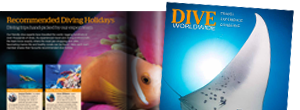A Dive Odyssey: The Wrecks of Truk Lagoon (Charlie Munns)

Since I first learned to dive in 1991, I have always known of a place called Truk. Back in 2000, I made the conscientious decision to leave my life in London and take a six month sabbatical. Little did I know, it would turn out to be more than 8 years!
I became an instructor in Thailand, before moving to Aruba, honing my skills on a number of WWII wrecks and also a predominantly North American clientele. During my time on Aruba, I made my application to work on the Truk Odyssey. After Aruba, I sailed and dived the entire length of the West Indies from Trinidad to St. Maarten. I lived on St. Kitts for nine months, instructing and catching lobster, all the while with my eye on the prize: Truk Lagoon. After months of electronic ping-pong with the Odyssey liveaboard, I was given my break and asked to join the team as their lead instructor and dive manger. (For anyone who asks, Truk is one of the more remote places on Earth. Even Fed-Ex struggled to work out how to send my work permit application!)
I joined the Truk Odyssey and quickly extended my work permit. As I say to anyone who will listen, I thought I knew how to dive, but then I went to Truk - the diving there is truly astonishing and it is hard to put into words. There will be some - many in fact - who think Truk diving is simply about boring bits of metal. For sure, Truk diving is pure wreck diving but it can offer so much more. For starters, the wrecks are teeming with life: hard and soft coral, inhabited by a myriad of critters, turtles chomping on sponges, rays snuffling around in the sand, sharks patrolling the perimeters. The list goes on.

The wrecks of Truk Lagoon are the legacy of the ferocious campaign in the Pacific. Following the attack on Pearl Harbour in December 1941, the American Navy sailed west, invading and choking off the supply routes to the Japanese occupied islands. On the 17th & 18th February 1944, it was time to hit Truk in a two day aerial campaign, known as Operation Hailstone. With a huge armada sitting outside the atolls, the Americans launched their deadly torpedo strikes, instantly knocking out the air defence and hitting ships at anchor or in retreat. Japanese losses totalled over 250 aircraft and 45 ships, including cruisers, destroyers, sub-chasers, tanks and cargo ships.

These ships have been laying at rest ever since. Many sit upright, some are listing, often in depths well within the 40 metre recreational dive limit. The water is always warm with zero current or thermocline. and visibility can easily exceed 30 metres. Although you can make the diving as technical as you want it to be, it is actually very simple - jump in, swim to the pointy end, turnaround and swim to the stubby end and get out. Repeat.
For those who dare, the diving really comes alive by penetrating the wrecks. Companionways lead to crew and captain’s quarters, the holds carry heavy machinery, live munitions litter many ‘tween decks, and the engine rooms offer a labyrinth of stairwells, gauges, tools and workshops. These are more than lumps of metal. You can still find personal items - I have found board games, newspapers, coins, medical bottles and pills, sunglasses and even statues. There is a soft and gentle side to these wrecks. They have a soul and history, in abundance.

I will be leading an exclusive trip to Truk Lagoon in March 2019 on board the Odyssey. Having spent two and a half years working on the Odyssey, I have made over 1,500 dives in the Lagoon. Along with the fantastic crew and guides, we can show you things you would never find by yourself, and I will be delighted to share my experience and knowledge and ensure you have a trip you will surely remember for a lifetime.
However, a word of warning: For those who make the trip to dive Truk, nothing else will match this experience!
Contact Charlie to book your place on this exclusive charter to Truk Lagoon - spaces are limited.








